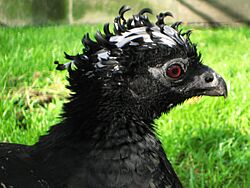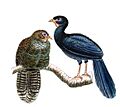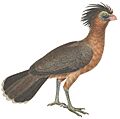Cracidae facts for kids
Quick facts for kids CracidaeTemporal range: Oligocene to recent
|
|
|---|---|
 |
|
| Yellow-knobbed curassow (Crax daubentoni) | |
| Scientific classification |
|
| Kingdom: | Animalia |
| Phylum: | Chordata |
| Class: | Aves |
| Order: | Galliformes |
| Family: | Cracidae Rafinesque, 1815 |
| Subfamilies | |
|
|
The chachalacas, guans, and curassows are birds that belong to the family Cracidae. These birds live in tropical and subtropical areas of Central and South America. One type, the plain chachalaca, even lives in the southernmost parts of Texas in the United States. You can also find two species, the Trinidad piping guan and the rufous-vented chachalaca, on the islands of Trinidad and Tobago.
Contents
How These Birds Are Related
The Cracidae bird family was first named by a French expert, Constantine Samuel Rafinesque, in 1815. These birds are a very old group. Scientists once thought they were related to the mound-building birds from Australia, called Megapodiidae. However, newer studies show that Cracidae and Megapodiidae are actually two of the earliest groups to branch off from the larger bird group called Galliformes.
| Galliformes |
|
|||||||||||||||||||||||||||
Family Tree of Cracids
This diagram, called a cladogram, shows how different types of cracids are related to each other. It is based on a study from 2021. The numbers show how many species are in each group, according to the International Ornithologists' Union.
| Cracidae |
|
||||||||||||||||||||||||||||||||||||||||||||||||||||||||||||
Types of Cracids
The Cracidae family includes many different types of birds, grouped into subfamilies and genera. Some of these types are now extinct, meaning they no longer exist.
- Subfamily Penelopinae (Guans)
- Genus Aburria (includes piping guans)
- Wattled guan, Aburria aburri
- Black-fronted piping guan, Pipile jacutinga
- Trinidad piping guan, Pipile pipile
- Genus Chamaepetes
- Black guan, Chamaepetes unicolor
- Sickle-winged guan, Chamaepetes goudotii
- Genus Penelope (15 species of guans)
- Band-tailed guan, Penelope argyrotis
- Crested guan, Penelope purpurascens
- White-winged guan, Penelope albipennis
- Genus Penelopina
- Highland guan, Penelopina nigra
- Genus Aburria (includes piping guans)
- Subfamily Cracinae
- Genus Ortalis (chachalacas, 16 species)
- Plain chachalaca, Ortalis vetula
- Rufous-vented chachalaca, Ortalis ruficauda
- Speckled chachalaca, Ortalis guttata
- Genus Oreophasis
- Horned guan, Oreophasis derbianus
- Genus Crax (curassows, 7 species)
- Great curassow, Crax rubra
- Yellow-knobbed curassow, Crax daubentoni
- Black curassow, Crax alector
- Genus Mitu (razor-billed curassows)
- Alagoas curassow, Mitu mitu (extinct in the wild)
- Genus Nothocrax
- Nocturnal curassow, Nothocrax urumutum
- Genus Pauxi (helmeted curassows)
- Helmeted curassow, Pauxi pauxi
- Genus Ortalis (chachalacas, 16 species)
How Cracids Changed Over Time

Scientists have studied the DNA and physical features of cracid birds to understand their family tree. They found that the main groups—chachalacas, guans, and curassows—are indeed distinct groups. The horned guan is special because it is the only living member of a very old and unique bird line.
Research suggests that the Cracidae family first appeared a very long time ago, during the Late Cretaceous period. However, it is hard to be exact because bird evolution can happen at different speeds. The fossil record for cracids is not complete, which makes it harder to know for sure.
Many new cracid species appeared quickly between 40 and 20 million years ago. This happened as the Andes mountains rose, creating new landscapes and river systems. These changes divided bird populations, leading to new species forming. This is why the different types of curassows and piping guans often live in areas separated by rivers.
What They Look Like

Cracids are large birds, similar in size and shape to turkeys. Guans and curassows usually live in trees. The smaller chachalacas prefer more open, bushy areas. Many of these birds have long tails, which helps them move around in trees.
Their feathers are usually dull in color. However, curassows and some guans have bright, colorful parts on their faces. These birds are also very noisy! The chachalacas even get their name from the sound of their call.
Cracids vary in size. The little chachalaca is small, about 38 centimeters (15 inches) long and weighing about 350 grams (12 ounces). The great curassow is much larger, nearly 1 meter (39 inches) long and weighing up to 4.3 kilograms (9.5 pounds).
Their Habits and Life
These birds mostly eat fruit, insects, and worms. They build their nests in trees. Females lay two to three large white eggs, and only the female sits on them to keep them warm.
When the young birds hatch, they are very developed. They can climb and find shelter in the nesting tree right away. They can even fly within a few days of hatching!
Images for kids













